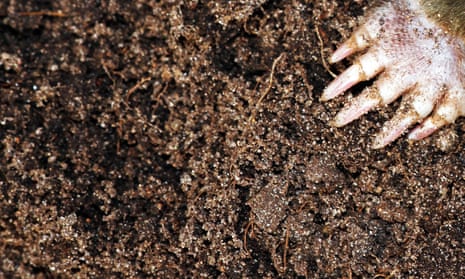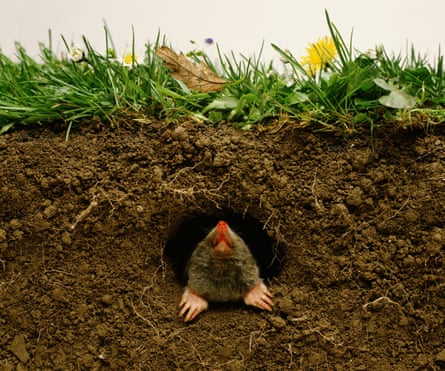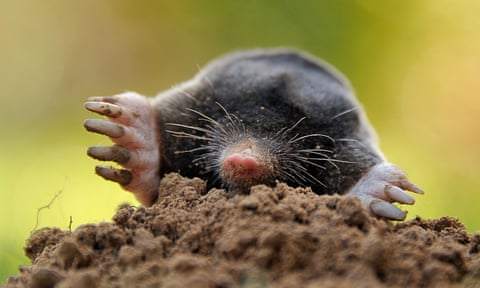Roger Page purchased his home in East Bilney, a Norfolk farming community, about 25 years ago. For the better part of those 25 years, he bore no ill will toward the moles. He was fond of wildlife, or at least what little of it remained in the country. A family of deer foraged in the backyard. Foxes lolled in the road at dusk. Moles were a rarity.
Page worked as a commercial pilot and when the occasional molehill erupted on his lawn, he would pat it down before departing again to New York or Hong Kong. They seemed to have an understanding, he and the moles. They mostly kept to the woods, while Page mostly kept to the garden.
But after he retired five years ago, Page expanded his back lawn and the moles became more persistent. As more and more molehills sprung up, Page came to feel as if their labours were engineered to produce in him the maximum anguish. He purchased traps at the garden centre, but they would often remain unsprung or – worse – sprung and empty.
He decided to escalate his counter-assault. During a stopover in Amsterdam, he bought a pungent bag of flower bulbs advertised as a natural mole deterrent. (The moles didn’t mind.) Next, he installed a solar-powered mole repeller, a torpedo-shaped device that emits vibrations that are supposed to keep the moles away. (The moles carried on.) He tried flooding them out with a water hose. (Moles are strong swimmers.) Finally, he tried suffocating them with the exhaust of his lawnmower. (Moles can survive in low‑oxygen environments.)
Page knew it wasn’t healthy to go on like this. Last September, he found the phone number of a woman named Louise Chapman, also known as the Lady Mole Catcher of Norwich. Traditional mole catching in Britain has experienced a resurgence following a 2006 European Union ban on strychnine, and Chapman is one of many trying to profit from the boom. A former drama teacher, she has been profiled in national newspapers and travelled to Australia in 2016 to be featured in the first season of a reality television show called Deadliest Pests Down Under, where she applied pink lipstick before hunting a funnel web spider. With the help of a business coach, she has also tried marketing Country Mole Catcher™ franchises across the country, offering newcomers to the business everything they need to get started for £7,500, plus a cut of their proceeds.
Chapman is a compact blonde woman, and – when she’s on the job – clad in Wellington boots. When we arrived at Page’s home, she popped open the back of her white Audi estate car and retrieved a bucket containing plastic flags, a garden spade and a long metal rod with a bulb on the end – a mole probe.
We followed Page to the side of his house. There, a ragged strip of lawn about the size of a tennis court lay dotted with patches of overturned earth, each patch spaced every two feet or so. The lawn looked as though it had been strafed by artillery. Chapman walked the length of it, taking note of small details: a crack in the soil, a dead patch of grass, a pile of fresh dirt. She saw herself as an archaeologist who could reconstruct the workings of an underground metropolis based on the scantest traces on the surface.
“I reckon there are three,” Chapman said at last. She gave Page a quote for the work: £80 for the first mole with the price dropping to £60 a mole for two or more. She couldn’t promise to dispatch them on the first visit or even the second one. It could take weeks, but he didn’t have to pay a penny if she wasn’t successful. “No mole, no fee,” they call it in the business. “You’ve already tried to catch them, and they might have got wily,” she warned.
Clients are sometimes taken aback by Chapman’s prices, which she makes a point of delivering in person. Page, however, readily agreed that it was worth it for his sanity, and Chapman got to work. She began by cutting a cube of turf from the roof of the mole run and carefully set it on the ground. Then, she inserted a trap shaped like a fizzy drink can into the hole and covered it with a few clumps of grass. This trap, known as the Duffus half-barrel and first patented in 1920, is based on traditional designs made of a clay or wooden barrel and a horsehair snare powered by a bent stick. In the modern metal trap, a spring-loaded wire loop functions as the snare. When the mole enters the device, it makes it halfway through this loop before brushing against the trigger. The wire loop then accelerates upward, crushing the mole against the trap’s curved roof.
Page was clearly torn between his desire to have an attractive lawn and the violent death he was about to sanction. “I don’t like killing animals,” he said. Chapman, on her hands and knees, looked up from her work. “You were driven to it,” she told him. When she had finished setting traps, she said that either she or her colleague Carole would return “in a few days”.
Chapman tossed off those last words casually, but they represented one of the most divisive issues in mole catching today. Unlike mousetraps, mole traps do not kill instantly and do not always kill cleanly. The world of mole catching is bitterly divided between those who believe that traps should be checked every 24 hours – to ensure that any injured moles are dispatched quickly, rather than being left to die a slow and agonising death – and those who don’t.
Because of the expense of driving out to check an empty trap day after day, opponents of such regulations argue that it would hasten the extinction of mole catching as it has been practised for centuries. “It will criminalise all the mole-catchers,” Chapman says. Britain would be overrun by molehills, which are not only unsightly, but can also potentially spread disease to livestock, trip up horses on race-courses, and ruin golf courses and football pitches. To professionals such as Chapman, such threats appear to outweigh the possibility that a maimed mole or an unfortunate weasel could be squirming in pain beneath someone’s lawn for days.

The idea of a professional who specialises in mole control can seem like a quaint relic from the past. In the 18th century mole-catchers were employed by every parish in England to keep the mole population under control. Catching these creatures required such skill that practitioners were remunerated more generously than surgeons. Mole-catchers zealously guarded their methods, divulging them only to their own children.
The earliest English descriptions of mole catching practically take the form of spells. Roger Sharrock, in 1660, advised his readers to cut up red herrings, burn them, and place the pieces in the mouths of molehills. In a pinch, garlic or leeks might also work. “I have not tryed these ways,” Sharrock added, “and therefore refer the Reader to his own tryal, belief or doubt.”
For a mole-catcher to be successful today, he or she must engage the client with the most romantic notions of his profession. This, at least, is the theory of Duncan Emmett, a mole-catcher in his 60s who has the long beard of a wizard. “If you take that magic away, if you take that showmanship away, then all you are left with is the killing,” Emmett told me at a dimly lit pub near his home in Biggleswade, Bedfordshire. “Because you have to kill the mole, haven’t you? That isn’t an easy thing for a lot of people to bear.”
Even in agricultural settings, mole catching still takes the form of an annual rite. Outside the town of Ludlow, near the Welsh border, I visited a sheep paddock where 40 or 50 dead moles had hung from a barbed-wire fence for so many years that their desiccated bodies had turned greenish from lichen. It looked like a ceremonial sacrifice. Although the practice is fading, mole-catchers employ such gibbets to prove that the promised work is completed, and farmers use them to niggle their neighbours into clearing their own fields.
The word “mole” is thought to derive from the middle English word mouldwarp, which literally means earth-thrower. The animals’ forelimbs are cartoonishly large, pink and practically hairless, and, apart from an extra digit, have the appearance of a doll’s hands. So prized were moles’ hands that farmers once kept them in silk bags as talismans for good luck and to ward off toothache, epilepsy and scrofula.
Moles dig their tunnel systems to catch earthworms, shoving the excavated earth out of vertical passageways to produce molehills. In a 1976 study, researchers counted 7,380 molehills on a single hectare of English pasture, estimating their total weight to be 64,500kg. Sheep that eat dirt from molehills can die from listeriosis, while winter feed for dairy cattle can become foul-tasting or toxic if contaminated by soil bacteria.
Moles can be detrimental in other ways as well. Nearly every British mole-catcher can tell you the story of King William III. On 21 February 1702, he was riding his horse at Hampton Court when it tripped on a molehill and threw him to the ground. He broke his collarbone and developed pneumonia, which killed him two weeks later. (His enemies in Scotland are said to have raised toasts to “the little gentleman in the black velvet waistcoat”.)
Mole control became a national policy in 1566, when a bitter cold period known as the Little Ice Age threatened England’s food supply. Queen Elizabeth passed “An Acte for the Preservation of Grayne”, which would remain in force for the next three centuries. The law prescribed bounties to be paid for the destruction of a long and dubious list of agricultural vermin, including everything from hedgehogs to kingfishers. Some parishes paid out a half-penny per mole, others appointed mole-catchers with contracts lasting up to 21 years. In addition to their salaries, mole-catchers sold the silky mole skins, which were prized for the tailoring of waistcoats.
In the early 20th century, worms dipped in strychnine became the preferred method for controlling moles on farms. The poison blocks nerve receptors along the spinal cord, causing the victim to become frantic and hyper-stimulated. Their body is overcome by painful convulsions which lead to a backward arching of the head, neck, and spine, a state known as opisthotonus. And because strychnine doesn’t break down in animal tissue, it can also ripple through the food chain when a bird of prey or even a domestic dog consumes a poisoned mouse or mole.
In 1963, when the House of Commons was debating a bill to ban the poison, David Renton, the minister of state for the Home Office, testified that moles “strangely enough” failed to show “the same symptoms of pain” as other animals. In the end, the law banned strychnine for mice and rats, but exempted moles because no ready substitute existed. In the following decades, British farmers purchased more than 50kg of strychnine each year – enough, in theory, to kill half a billion moles. (The entire mole population in Great Britain has been estimated at 31 million.)
The poison was only phased out with the European Union’s new pesticide regulations in 2006, which led British newspapers to make grave predictions of a mole explosion. At the same time, the regulation led to the rise of the modern mole-catcher, drawing in dreamers who wanted to make a living from this unusual business.
When Louise Chapman first started trapping moles in 2014, she joined an organisation named the Guild of British Molecatchers and took a class with its founder, Jeff Nicholls, who is considered a leading authority on the topic. The Guild, which was founded in 2008, is one of three mole-catching organisations in the country and has about 150 dues-paying members, along with 200 registered supporters.

Unlike the British Mole Catchers Register and the Association of Professional Mole Catchers, the Guild has strict rules about checking traps daily. A letter that the Guild sent out to members in 2009 explained that daily trap checking was “gaining a strong momentum from numerous sources” and the Guild had adopted “a self-regulating stance before it is dictated to us by some bureaucratic directive in Brussels”.
Chapman claims to have known none of this and, one day in October 2014, she was surprised to receive notice that she was being kicked out of the Guild. Its agents had evidently discovered that she was failing to follow its rules. “I tried being reasonable, and they don’t want to play like that,” Chapman told me.
Chapman didn’t just join a competing organisation, she bought up one that already existed. Membership in the British Mole Catchers Register would give mole-catchers credibility and visibility, she promised. At £75 per year to join, it also costs nearly twice as much as the Guild.
When I first began looking into the Guild of British Mole Catchers, I was surprised to find that Jeff Nicholls’s name is not included in the list of officers on the website. He had spoken to me briefly by telephone, but later proved difficult to communicate with, responding to my emails erratically and failing to answer my questions directly. He was friendly in a way, but he expressed a fear that I might invalidate his life’s work. He was, he told me, on the verge of a kind of breakthrough in ensuring higher welfare standards for the mole, and he was concerned about his own safety. “I’ve been told to sleep with one eye open because I might smell smoke,” he told me, referring to an anonymous phone call he had received from a molecatcher who was unhappy with his efforts on behalf of Britain’s moles. I decided that I had to meet him in person.
It had just stopped raining when I arrived at the Royal County of Berkshire Show, held near Reading. The air was heavy with the scent of wet grass and animal manure. After circling the grounds, I finally found what I was looking for: a makeshift arena decorated like a Smurf village with artificial flowers, cartoon backdrops, and two wooden chests with signs warning: “Danger Keep your Distance”. A stout man with a rosy complexion popped out from a tent behind the stage. Nicholls had a red scarf around his neck, a canvas hat on his head, and a headset microphone bent in front of his mouth. “Ladies and gentlemen,” he announced, “I’m a professional grass shark hunter.” With that, the show began.
On stage, Nicholls directed his wife to remove the chains from a number of boxes, and warned onlookers to run in the other direction should he drop them. He cracked the lid of one of the boxes and produced a 3ft-tall mole puppet he had had custom made in California. It was named Freckles. Over the course of the half-hour show, as Nicholls delved into the mole’s life and habits, his style shifted from corny to educational and back again. “Do moles smell?” he asked. “If you leave them in the back of the car, they do.”
After the show, I introduced myself and Nicholls eyed me suspiciously. He warmed a little as his passion bubbled up and he offered me a cheese and onion sandwich from his cool box. “I just want to fight for the moles, who have had such a bad deal for so many years,” he said.
Nicholls has been catching moles since he was a boy, when he had to make his own traps, and all those years of killing had not numbed him to the plight of his prey. It had only furthered his certainty that they deserve better. What he wanted was a simple thing. The government currently recommends that mole-catchers check their traps daily to ensure that moles are not suffering unduly. Nicholls would like that rule change to be mandatory.
“I say to my boys – my youngest is 26 – when you leave this planet, you must leave something behind or there’s no point in being. Either a book or a song or a sculpture,” Nicholls said. “My path is moles. I must do something for them, get this welfare for them before I leave this planet.”
There is something jarring about the idea of a humane kill, as though the fact of taking a life can be mitigated by minimising the pain inflicted during death. Most authorities agree that what is known as the “time to irreversible unconsciousness” is the relevant variable in determining how humane a kill-trap is. Whereas a standard mouse trap will dispatch the animal instantly by snapping the spine from above, the Duffus style of mole trap applies its blow to the chest, with less predictable results.
The shortcomings of the Duffus trap have been known for a long time. In 1951, a committee reporting to the British legislature on animal cruelty wrote that “the spring of the ordinary type of mole-trap was too weak to kill instantaneously”. More recently, a 2004 report on mole control by the Department of Environment Farming and Rural Agriculture (Defra) concluded that, “The performance of existing kill-traps (or the way they are used) is questionable as a more humane alternative to the use of strychnine.”
I saw the brutality of the Duffus trap with my own eyes when I rode around with a mole-catcher named John Noblett, whose work largely comes from dairy farms in Lancashire. Noblett is the embodiment of the 21st-century mole-catcher, a straight-shooter with no time for the theatre of some of his colleagues. He sometimes bags more than 6,000 moles per year, and he sets so many traps that he has a GPS mounted on his quad bike to pinpoint their location. He has earned the title “Master Mole Catcher” from the Guild and wants nothing more than a clean, humane kill.
When he pulled one freshly-laid trap from the ground, the mole inside was still alive with the thin belt of metal cinched around its waist. All four of its feet were waving around in sad circles. Noblett whipped the animal against a metal box on the back of the idling quad, and the life went out of it. He set the limp creature down on its side. A perfect sphere of blood bubbled up out of its ear.
Nicholls, as part of a lobbying effort, has amassed a dossier of suffering, collating his own disturbing accounts and testimonies from like-minded colleagues such as Noblett. The 37-page report, which Nicholls shared with me, contains a photograph of a mole caught by just one paw. Another, by its snout. According to Nicholls, other styles of traps, including the popular scissors trap, are generally less humane than the Duffus. In the report, Nicholls describes how he has spent years setting traps and waiting for them to trigger, so that he could closely monitor their efficacy. “It was a long process and worth every hour,” he writes. What he witnessed confirmed all his worst suspicions about the cruelty of his beloved profession. Never once did he witness a mole receive a fatal strike. Quite regularly, he saw moles struck below their bellies struggling for more than five minutes as their bodies filled with blood. “I was in fact allowing moles to suffer in the traps I set – this undetected misery was in my hands and was and is totally unnecessary suffering.”
The observations led Nicholls, in 2008, to design a modifed Duffus trap for Procter Brothers, a Welsh company founded in 1740. This trap, which has a stronger spring to make it a more efficient killing machine, is widely available, but there is no legal requirement to use it over other trap styles.
Under the Pests Act of 1954, trappers can only use approved traps to kill stoats, weasels, rabbits, and squirrels and they must be checked at least once per day. Nicholls cannot understand why moles and rodents do not merit the same protection. Several years ago, a European Union study on trapping vindicated Nicholls’ views, concluding that “there is no scientific justification for not including all species” in trapping regulations and that kill traps “should be inspected once every 24 hours”. While some may think live trapping moles offers a humane alternative, a wet mole in a cold plastic tube can quickly succumb to starvation or hypothermia. (There is also the question of where to release them. Because moles are highly territorial, if they are released in a neighboring territory, they will potentially tear each other to pieces.)
Nicholls is tight-lipped about his government contacts, but he has had the ear of politicians such as Chris Davies, a Liberal Democrat and former member of the European parliament, who previously came out in support of the strychnine ban. Bernard Donoughue, the Labour peer and former minister for Farming and the Food Industry, was once listed on the Guild’s website as a “patron”. In the last year, Nicholls claims he has got his report in the hands of someone “as high as you can go” at Defra, which has the power to set trapping regulations.
One reason that Nicholls is so careful not to reveal too much about his political contacts is that at every opportunity he has had to advance his cause, he has been foiled by his nemesis, Duncan Emmett. In 2008, Emmett cofounded the Association of Professional Mole Catchers, as a counterweight to the Guild of British Mole Catchers. When Nicholls tried to get the Guild’s code of practice endorsed by an umbrella organisation of British pest controllers, Emmett rallied his own members to halt it. When Emmett heard that Nicholls was trying to get new rules passed in Scotland, he filed freedom of information requests with the government so that he could challenge it. (Emmett declined to share the information he obtained from these requests.)

When I spoke with Emmett, he told me that daily trap-checking would be devastating to his members because of the potential cost and time required to drive out to the same yard again and again. Nor did Emmett believe that such rules would achieve any measurable advancement in mole welfare. Why not check traps twice a day as they do in Sweden? Or every four hours? Or five minutes?
Despite putting up a good fight, Emmett admitted that a rule change is inevitable. The public concern over animal welfare will, he believes, be decisive. “He [Nicholls] will pull it off in the end,” Emmett said. “People don’t want a mole in their garden, but they don’t necessarily want to see it cut in half and displayed on their gate.”
In an era when farmers and foodies alike have embraced the idea of sustainability, a call to a pest controller, with their traps and chemicals, feels like a sin. The central dilemma of the modern mole-catcher is to demonstrate that not only are their services ethically sound but that they are also valuable and necessary. Some scientists believe this may not be an easy task.
On a blustery Sunday morning, I met Rob Atkinson near his home in Ludlow. Atkinson is the former chief scientist for the RSPCA and author of the natural history book The Mole. Although he corresponded with Nicholls while at the RSPCA and has supported research on mole traps, he came to realise that they had different goals. For Atkinson, it wasn’t enough to find nicer ways to kill moles – he didn’t want them to be killed at all.
Atkinson is a soft-spoken, thoughtful man who has wavy grey hair and a downy white beard, and I couldn’t imagine him harming a single creature. He admitted to me, however, that he was once tasked with clearing moles out of his parents’ garden. He still remembers the excitement he felt when he would see a sprung trap. But, he added, “even, then, there was this sadness”. The landscape, once dynamic and alive, soon grew still. The rain washed over the molehills and they gradually flattened out. “You’ve done what you intended to do, but there’s a feeling that something is gone that was once here,” he said. Moles are in no danger of becoming extinct, but they are a reminder of Britain’s ancient natural history. Unlike other species, such as the grey squirrel, which were introduced by humans in recent centuries, the resident mole has lived in Britain for more than 350,000 years.
In the late 1980s, Atkinson studied the lives of moles while working on his master’s degree at the University of Oxford. He interviewed farmers about their impact, and tracked the movements of moles in the field. He came to the conclusion that mole catching was, for the most part, useless – a practice that should have died out years ago. In fact, scientists believe that moles benefit vegetable crops by turning the soil and eating pests. Overall, the annual cost of moles to the £25bn British agriculture industry has been estimated at less than £5m. “If you don’t like them on your lawn, does that give you a reason to kill them?” Atkinson asked me.
He told me about one particular moment that had stayed with him from his research around Oxford. It was summer and dry weather had driven the moles so deep underground that he rarely saw much activity on the surface. Then, one evening at dusk, Atkinson was walking through a field when he heard a noise like crinkling paper. It was the sound of grass roots snapping. The ground rose up, creased and fissured. Earthworms fled to the surface.
The earth split open. Atkinson spotted a mole’s snout poking through the soil, periscope-like. He fell to the ground and dangled a live worm. The mole snatched it between its jaws. It didn’t swallow the worm immediately. Instead, it ran its claws along the length of the worm, sloughing the unwanted dirt from inside the translucent body like small pink fingers squeezing a tube of toothpaste. It was one of the most magnificent things that Atkinson had ever witnessed. Next thing he knew, the mole had gobbled up the worm and disappeared.
Main image: Tony Evans/Timelaps/Getty Images
This article was amended on 13 March 2017. The misreading of a graph and a further miscalculation resulted in the author originally stating that in the decades after the 1960s British farmers purchased more than 50,000kg of strychnine each year – enough, in theory, to kill 2.5bn moles. Those figures should have been 50kg and half a billion respectively. This has been corrected.






